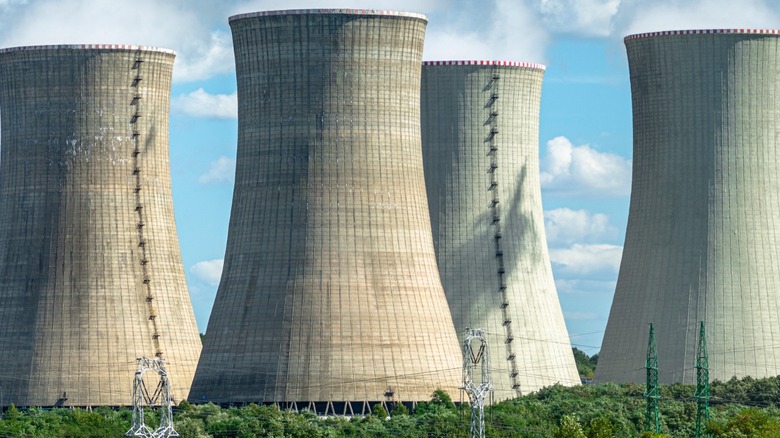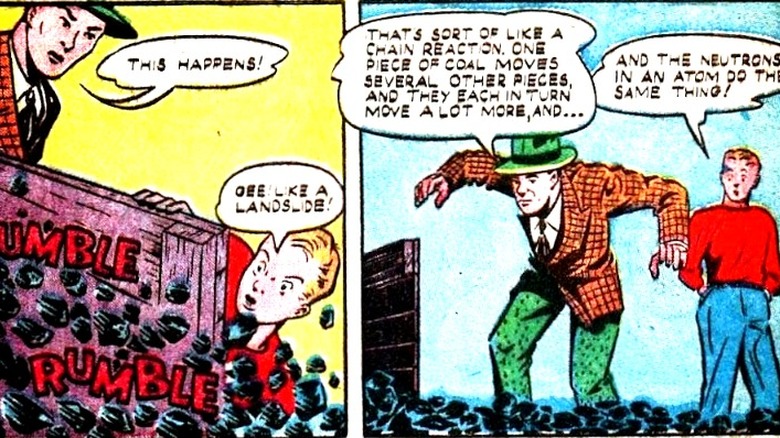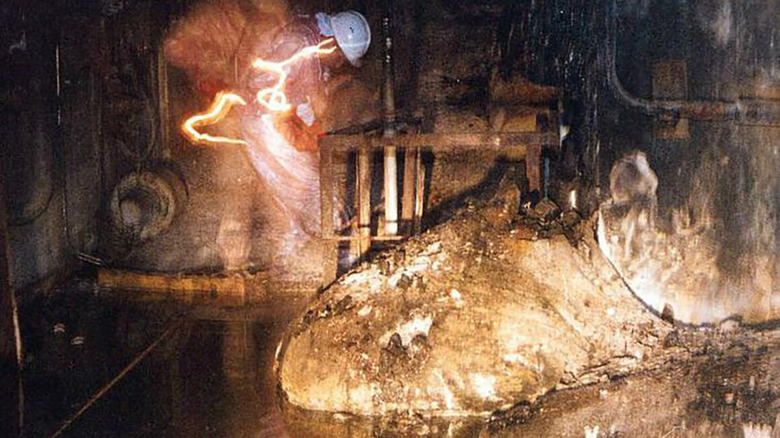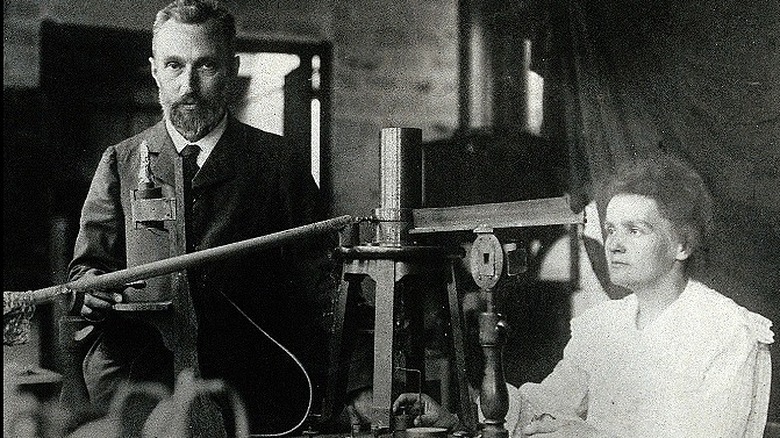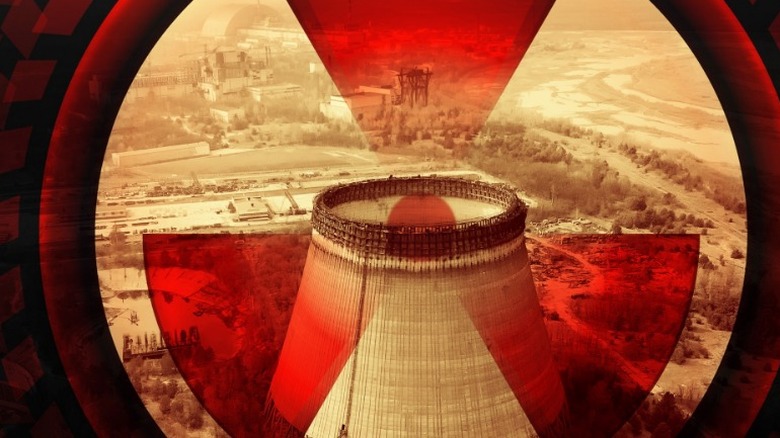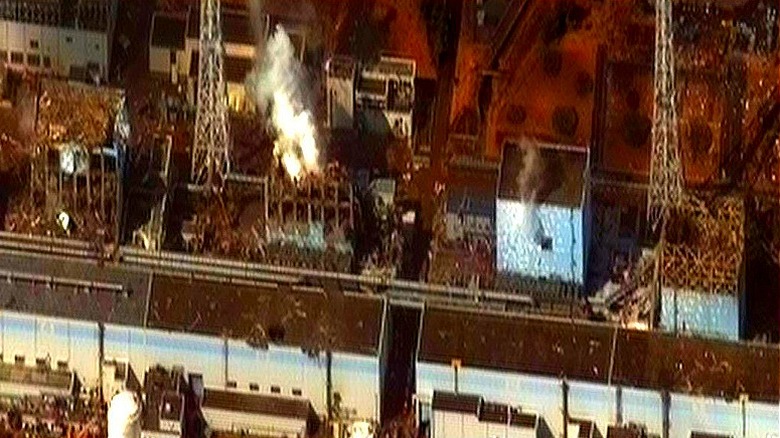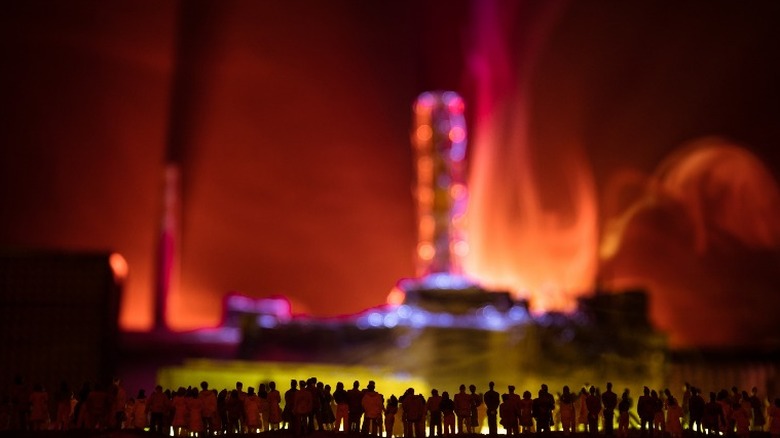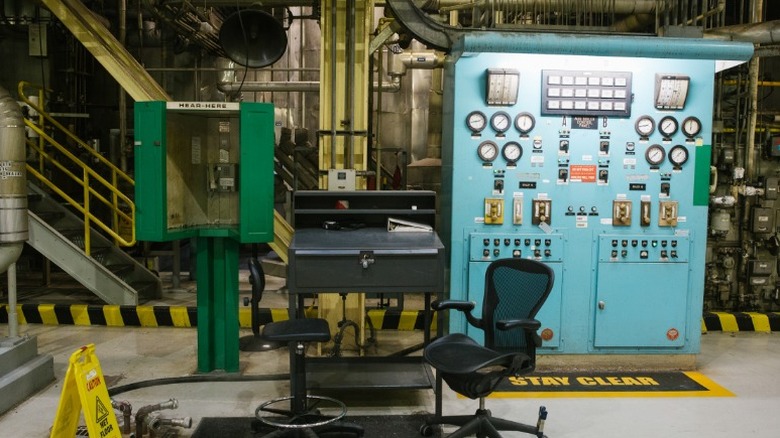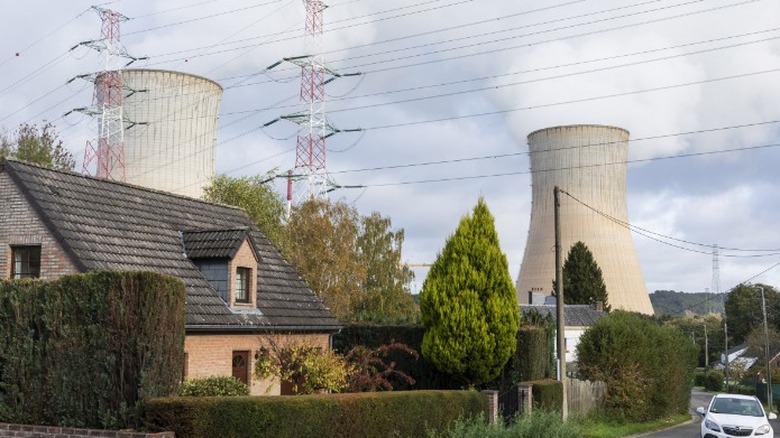What Happens If A Nuclear Power Plant Melts Down?
For many of us, the term "nuclear meltdown" scares up images of mushroom clouds and fireballs blasting their way to the center of the Earth, "China Syndrome" style. Although nuclear power plants are designed with safety, not destruction, in mind, the risk of deadly contamination is always there. As noted by the BBC, Russia's bombardment of the Zaporizhzhia nuclear plant in Enerhodar -– the largest plant in Europe -– and the takeover of the defunct Chernobyl plant in northern Ukraine revived global concerns about nuclear plant meltdowns not expressed since Japan's Fukushima reactor accident in 2011. Haunted by the possibility of nuclear plants in Ukraine being misused during military operations, fears about worst-case scenarios have reignited.
So worrisome are the potential dangers of a nuclear plant meltdown that immediately after the Zaporizhzhia bombing, questions about the legality of Russia's targeting of the nuclear plant erupted. According to the Bulletin of the Atomic Scientists, the Zaporizhzhia attack violated Article 56 of Protocol I of the Geneva Convention, making it a potential war crime. The Zaporizhzhia bombing even prompted an emergency meeting of the U.N. Security Council, during which the United States ambassador described the assault as a "dire threat to the world." While the attack's objective might have been to reduce Ukraine's energy supply, not unleash a nuclear disaster, the potential for a catastrophic meltdown, accidental or deliberate, nevertheless looms large.
Nuclear power starts with a little atom and a lot of fission
As noted in Scientific American, nuclear power plants can be described as "high-tech [tea] kettles" that produce electricity by boiling water. To get the water to boil, the power plants harness nuclear fission -– where one atom subdivides into two parts of equal mass (via Britannica). These split atoms generate heat and send "neutrons flying." With those neutrons floating around, they can get gobbled up by another atom. Then that atom "becomes unstable and undergoes fission itself, releasing more heat and more neutrons." Once this happens, the cycle essentially continues over and over again, continually producing heat.
According to the U.S. Energy Information Association, nuclear power plants turn ordinary fission into fuel with the help of enriched uranium. Formed into ceramic pellets encased in hard metal cladding, the radioactive fuel is placed in 12-foot fuel rods, which are bundled inside the center, or core, of the reactor. Each pellet produces the equivalent energy of 150 gallons of oil, and every reactor core contains many bundles, or assemblies, of fuel rods. The heat created in the fuel rods through the fission process is used to create steam that powers turbines, which then power generators that make electricity. The steam is cooled back into water via a cooling tower, or by such natural water sources as a river or ocean. Cooling the fission-produced steam is key to nuclear plant safety.
What causes a nuclear power plant to melt down?
What causes meltdowns? According to Howstuffworks, while the mechanism of meltdowns may be human error, natural disasters, or malfunctioning parts, the cause is always heat. Because the fission manufactured in the nuclear core is self-sustaining, with the fuel rods being hit with neutrons from prior fission reactions, the heat created by this fission (called decay heat) is also self-perpetuating. Without artificial intervention, the heating process goes on and on, and the heat builds and builds. Eventually, things will heat up to the point of destruction, and radiation will be released from the core. This is basically the point of no return — despite human intervention shutting things down, "the uranium and even radiated tools and parts will continue to generate decay heat."
To prevent overheating, coolants are pushed past the fuel rods in the nuclear core. According to U.S.NRC, plain old water is the most common coolant in U.S. nuclear plants. Heavy water, air, carbon dioxide, helium, liquid sodium, and a sodium-potassium alloy are also used. As noted in Scientific American, in most nuclear reactors, electrical pumps push the coolant past the core and carry the core's heat elsewhere. Most nuclear accidents happen when the circulation of coolant through the core somehow slows or stops. Even if the fission process itself is halted, without coolants, the nuclear core will continue to generate heat and spew radiation into the environment.
What melts in a nuclear plant meltdown?
The term "meltdown" has become a catch-all to describe any nuclear power plant failure, but as noted by Howstuffworks, meltdowns come in two sizes, partial and full. In any meltdown, the fuel rods are the first to go. A meltdown is deemed partial if the fuel rods overheat and melt, but coolant circulation is restored before any other reactor parts are affected. Total meltdowns happen when coolant circulation isn't quickly revived and core remnants essentially melt through everything.
As described by Physics World, during a total meltdown, "a radioactive lava-like mixture of nuclear fuel, control rods, fission products and the reactor's structural components can form." When the protective casings melt and rupture, the radioactive lava, called corium, falls out and starts spreading. According to former U.S. Nuclear Regulatory Commission (NRC) member Peter Bradford (via Scientific American), overheating will also cause the cladding to interact with the water and initiate a "high-speed rusting," which sets free hydrogen. When the hydrogen is vented with the steam and ends up in an area where oxygen is present, the two combine, causing the hydrogen to become hazardous. In other words, a total, worst-case meltdown can result not only in long-lasting, widespread radioactive contamination but fires and explosions as well.
What to do in the case of a nuclear meltdown
Duck and cover? That Cold War era prescriptive for surviving fallout from a nuclear bomb attack was naively simple, but it offered effective steps you can take to protect yourself from radiation exposure. According to the Mayo Clinic, in the event of a nearby radioactive nuclear plant meltdown, you should "shelter in place" and wherever you are, you should turn off all appliances (fans, air conditioners, and heating units) that bring in outside air and close fireplace dampers; bring your pets indoors; move everyone to an inner room or basement; listen to your emergency response network or the local news; and "stay put" for a minimum of 24 hours. If you're ordered to evacuate, evacuate!
Ready advises that if you were outside during radiation exposure or fallout, go inside (preferably to a brick or concrete building) and remove contaminated clothing and wash unprotected skin, avoiding your eyes, nose, and mouth. Stay away from outer walls and the roof, wear a mask, and keep a distance of at least 6 feet between yourself and non-household members. Pets that were outdoors at the time of exposure should be brushed or bathed. Eat only packaged foods and drinks that were inside at the time of contamination. If possible, connect virtually with your community.
What is radiation sickness?
As noted by The New York Times, radiation sickness first came to the public's attention through the untimely deaths of physicist Marie Curie and others conducting hands-on research of radioactivity. Although Curie played down her work's lethal effects, the medical community eventually recognized the danger inherent in exposure, and radiation safety measures were enacted. According to the EPA, all forms of ionizing radiation –- radiation with enough energy to knock out atoms -– can mess with the atoms in living cells and damage their DNA. While intermittent exposure to low doses of radiation, such as radiation from x-rays, poses little health danger, exposure to a high dose can sicken and even kill.
During a total nuclear plant meltdown, plant workers may be exposed to extremely high radiation doses –- the equivalent of 18,000 chest x-rays spread across the entire body. As described by U.S.NRC, high-dose exposure can cause immediate damage to tissues and organs, thus causing "acute radiation syndrome" — a whole-body response that can result in death. With less intense exposure, the symptoms of radiation sickness will vary depending on how much radiation is absorbed by the body and which parts of the body are exposed, according to the Mayo Clinic. Nausea and vomiting, either immediately or shortly after exposure, are the most common symptoms of less severe exposure.
What are the long-term health implications of radiation exposure?
As noted by the EPA, radiation doses are measured in millisieverts (international units) or rem (U.S. units) and can reflect a one-time exposure or accumulated exposures. The EPA has established that a total exposure under 10 rem -– which would allow for numerous x-rays and scans-– does not pose a health risk to the vast majority. A single 500 rem dose can be fatal if untreated, while a 100 rem dose can cause skin reddening and nausea, and 25 rem dose can lead to temporary sterility in men, according to U.S.NRC. During the Chernobyl nuclear meltdown, 134 plant workers and first responders received doses between 700 and 13,400 rem, and 28 of them died.
Although the symptoms of radiation sickness can be severe and unpleasant, patients generally recover, according to the Mayo Clinic. However, radiation doses can also go into a period of latency within the body, then trigger cancerous growth and heart disease years later. Nuclear plant workers exposed to repeated small doses of radiation, increasing their radiation rem over time, are known to have a greater cancer risk than the general population. Birth defects have also been attributed to radiation exposure, as per the CDC. And as reported by WHO, 20 years after the accident, residents living in contaminated areas around the Chernobyl plant had experienced high rates of thyroid cancer. Less reported but equally important, residents also suffered from crippling mental issues caused by the uncertainty surrounding their health.
Japan's Fukushima was a man-made disaster courtesy of Mother Nature
As chronicled in World-Nuclear, on March 11, 2011, in the wake of the Great East Japan 9.0 magnitude earthquake, a nearly 50-foot tsunami smashed into the Fukushima Daiichi nuclear reactor in northeastern Honshu Island. Like other power plant reactors around the island, three Fukushima Daiichi reactors had shut down automatically following the earthquake and showed no significant seismic damage. However, the tsunami knocked out the power supply, including backup generators, and without electricity, the coolant system that dumped reactor waste heat and decay heat into the sea couldn't operate. According to the Bulletin of the Atomic Scientists, fuel was left exposed and overheated after the water inside the reactors dissipated causing steam to produce combustible hydrogen gas. Explosions ripped through the containment buildings, releasing dangerous radioactive gasses.
A nuclear emergency was soon declared, and an evacuation was ordered. Within three days, the three nuclear cores had mostly melted, and based on the level of released radiation, the accident was rated 7, or major. Stabilization of the reactors took two weeks, and complete cooling wasn't achieved until December. Plant workers then had to scramble to prevent the release of radioactive water from the reactors. Surprisingly, no deaths resulted from the initial accident, according to BBC, and while many workers were exposed to radiation, a 2021 UN report announced that no adverse health effects had been detected among area residents. Despite this assessment, many residents refused to return to their homes.
Chernobyl was the perfect storm of poor design and horrifying politics
As noted by Britannica, the April 1986 nuclear plant meltdown in Chernobyl, Ukraine, stands as the worst accident in the history of nuclear power. The meltdown started in Unit 4 of the four-reactor plant during a testing phase. For the test, while the reactor was running at 7% power, operators shut off power-regulating and emergency safety systems and pulled out most of the core control rods. These actions destabilized the reactor, and according to World-Nuclear, the peculiar design of the control rods led to a huge power surge when the rods were reinserted. The fission in the core spun out of control, causing explosions and a fireball, and graphite that was being used as a coolant caught fire. Large amounts of radioactive material were released, and a partial meltdown of the core also ensued.
As described by U.S.NRC, emergency crews dropped sand on the fires and boron on the reactor debris. Weeks later, Unit 4 was covered in a concrete structure, dubbed the "sarcophagus." Residents in the immediate area were quickly evacuated, but the Soviet government tried to cover up the disaster from the broader public, even while winds were blowing radioactivity several times higher than was released on Hiroshima and Nagasaki. A huge swath of forest and farmland was contaminated, and thousands of people faced evacuation. Along with the plant workers and emergency crews, many residents suffered long-term radiation-induced illnesses, some fatal.
Three Mile Island was a partial meltdown that led to a total overhaul
The partial March 1979 meltdown at Pennsylvania's Three Mile Island power plant was the most serious nuclear accident to occur in the U.S., according to History. The accident occurred when a pressure valve in one of the reactors malfunctioned, failing to close and allowing contaminated cooling water to drain into the adjoining buildings. Loss of the coolant then caused the reactor core to overheat. Although emergency cooling pumps kicked in, control room operators misinterpreted confusing readings from the pumps' system and shut them off. The reactor was also shut down, but decay heat continued to be released, and by the following morning, the core was nearing total meltdown temperature. Radiation was spreading, and while the power company downplayed the accident, the governor was on the verge of issuing evacuation orders. That night, operators realized that the water pumps needed to be restarted, and the core's temperature started dropping. Two days later, however, a hydrogen gas bubble was discovered from the partially melted reactor, but crews were able to bleed the gas before the reactor reheated.
As noted by U.S.NRC, while no serious casualties or contamination resulted from the accident, the public fallout was immense. Increased fear and mistrust of the nuclear industry led to an increase in government regulations and oversight. Many design improvements were implemented, and new plant management protocols were instituted. Also included in the overhaul was a commitment to greater openness and sharing of expertise.
What are the best ways to prevent nuclear plant meltdowns?
Despite their dangers, many nuclear power plants are in operation around the world, and, as noted by Intelligencer, the industry is thriving. According to World-Nuclear, 440 nuclear reactors that are currently operating in more than 30 countries produce 10% of the world's electricity. New nuclear facilities are being built in 19 countries, with China, in particular, investing heavily in their construction.
How safe are these facilities? As reported in World-Nuclear, as a result of prior accidents, nuclear plants have been redesigned with safety in mind, and international operational standards have been established. Western world facilities now operate using a "defense-in-depth" approach, which features "equipment which prevents operational disturbances or human failures and errors developing into problems," close monitoring and regular testing of equipment, "redundant and diverse systems to control damage to the fuel," and keeping fuel damage confined to the plant. Specific safeguards include construction of physical barriers between the core and the environment, and the creation of multi-layered safety systems with backups.
No nuclear power plant has been built to withstand military attacks, however, and as reported in The Washington Post, areas like spent fuel pools make particularly vulnerable targets. As Rod Ewing, co-director of Stanford's Center for International Security and Cooperation, explained, while "nuclear reactors would not explode like a bomb ... they could cause even more widespread damage than nuclear weapons because they contain years of buildup of highly radioactive fission products."
